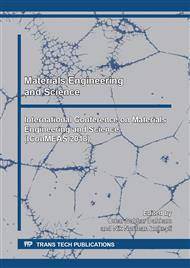[1]
Choolaei, M., Rashidi, A. M., Ardjmand, M., Yadegari, A., & Soltanian, H., The effect of nanosilica on the physical properties of oil well cement, Mater. Sci. Eng., A 538 (2012) 288–294.
DOI: 10.1016/j.msea.2012.01.045
Google Scholar
[2]
J.B. Laudet, A. Garnier, N. Neuville, Y. Leguen, D.Fourmaintraux, N. Rafai, N. Burlion, J.F. Shao, The behavior of oil well cement at downhole CO2 storage conditions: static and dynamic laboratory experiments, Energy Proc.4 (2011)5251–5258.
DOI: 10.1016/j.egypro.2011.02.504
Google Scholar
[3]
K. Nakanoa, A. Ohbuchib, S. Mitoa, Z. Xue, Chemical interaction of well composite samples with supercritical CO2 along the cement sandstone interface, Energy Proc. 63 (2014)5754–5761.
DOI: 10.1016/j.egypro.2014.11.608
Google Scholar
[4]
Sobolkina, A., Mechtcherine, V., Khavrus, V., Maier, D., Mende, M., Ritschel, M., & Leonhardt, A., Dispersion of carbon nanotubes and its influence on the mechanical properties of the cement matrix, Cement Concr. Compos. 34 (2012) 1104–1113.
DOI: 10.1016/j.cemconcomp.2012.07.008
Google Scholar
[5]
F. Nima, A. Abang, D. Ramazan, et al., Effect of halloysitenanoclay on mechanical properties, thermal behavior and microstructure of cement mortars, Cem. Concr. Res.48 (2013) 97–104.
Google Scholar
[6]
Kong, X.; Ohadi, M. Applications of micro and nano technologies in the oil and gas industry-an overview of the recent progress. In Proceedings of the Abu Dhabi International Petroleum Exhibition and Conference, Abu Dhabi, UAE, 1–4 November 2010; Society of Petroleum Engineering: Richardson, TX, USA, (2010).
DOI: 10.2118/36188-ms
Google Scholar
[7]
Guo, K.; Zhang, Y.H.; Shi, Q.; Yu, Z.X. The effect of carbon-supported nickel nanoparticles in the reduction of carboxylic acids for in situ upgrading of heavy crude oil Energy Fuels (2017), 31, 6045–6055.
DOI: 10.1021/acs.energyfuels.7b00809
Google Scholar
[8]
Guo, K.; Hansen, V.F.; Li, H.L.; Yu, Z.X. Monodispersed nickel and cobalt nanoparticles in desulfurization of thiophene for in-situ upgrading of heavy crude oil. Fuel (2018), 211, 697–703.
DOI: 10.1016/j.fuel.2017.09.097
Google Scholar
[9]
Zhang, T. Modeling of Nanoparticle Transport in Porous Media. PhD Thesis, University of Texas Austin, Austin, TX, USA, (2012).
Google Scholar
[10]
K.M. Jadid,Chemical alteration of oil well cement with basalt additive during carbon storage application, MSC thesis, Middle East Technical University, The Graduate School of Natural and Applied Sciences, Ankara (2011).
Google Scholar
[11]
American Petroleum Institute Specification for Cements and Materials for Well Cementing API Spec 10A. Washington DC: API,(2010).
Google Scholar
[12]
Shuang Deng a.Mechanical properties and microstructure of oil well cement stone enhanced with Tetra-needle like ZnO whiskers;(2017).
DOI: 10.1016/j.conbuildmat.2016.12.051
Google Scholar
[13]
Utami Yerikania. The Strength Compatibility of Nano-SiO2 GeopolymerCement for Oil Well under HPHT Conditions;(2015).
Google Scholar
[14]
Dr. Hassan Abdul Hadi. Experimental Investigation of Nano Alumina and Nano Silica on Strength and Consistency of Oil Well Cement;(2017).
Google Scholar
[15]
Vipulanandan1 and Donald Richardson. Piezoresistive Behavior of Modified Oil Well Cement with Nickel Nanoparticles;(2013).
Google Scholar
[16]
T.Phoo-Ngernkham, V.Sataand S. Hatanaka, Arab. J.Sci. Eng., 41, pp.1263-1271(2016).
Google Scholar
[17]
M. K.Gopalan, ACI Mater J.,90, p.117–121(1993).
Google Scholar
[18]
F. Sanchez and K. Sobolev, Nanotechnology in concrete – A review,, Construction and Building Materials, vol. 24, pp.2060-2071, (2010).
DOI: 10.1016/j.conbuildmat.2010.03.014
Google Scholar
[19]
G. Isaia, A. Gastaldini and R. Moraes, Cement Concrete Composite, 25, p.69–76 (2003).
Google Scholar
[20]
Falode, O. A., Salam, K. K., Arinkoola, A. O. and B. M. Ajagbe,Predictionof Compressive Strength of Oil Field Class G Cement Slurry using Factorial Design,, Journal of Petroleum Exploration ProductionTechnology, (2013) Vol. 3, pp.297-302.
DOI: 10.1007/s13202-013-0071-0
Google Scholar
[21]
Huwel, J.P. E., Faustino, V. and Roberts, R. Cement Compressive Strength Development Drastically Affected by Testing Procedure,, Proceedings of American Association of Drilling Engineers Fluid Conference and Exhibition, Houston, Texas, (2014), pp.1-5.
Google Scholar
[22]
Alp, B. and Akin, S. Utilization of Supplementary Cementitious Materials in Geothermal Well Cementing, Proceedings of Thirty-Eighth Workshop on Geothermal ReservoirEngineering, Stanford University, Stanford, California, (2013), p.1 – 7.
Google Scholar
[23]
Lalan, P., Dauzères, A., De Windt, L., Bartier, D., Sammaljärvi, J., Barnichon, J.D., Techer, I., Detilleux, V., 2016. Impact of a 70◦C temperature on an ordinary Portland Cement paste/clay stoneinterface: aninsitu experiment. 164178, http://dx.doi.org/10.1016/j.cemconres. 2016.02.001.
DOI: 10.1016/j.cemconres.2016.02.001
Google Scholar
[24]
API Specification 10A, 23rd edition, April 2002, ANSI/API 10A/ISO 10426-1-(2001).
Google Scholar


